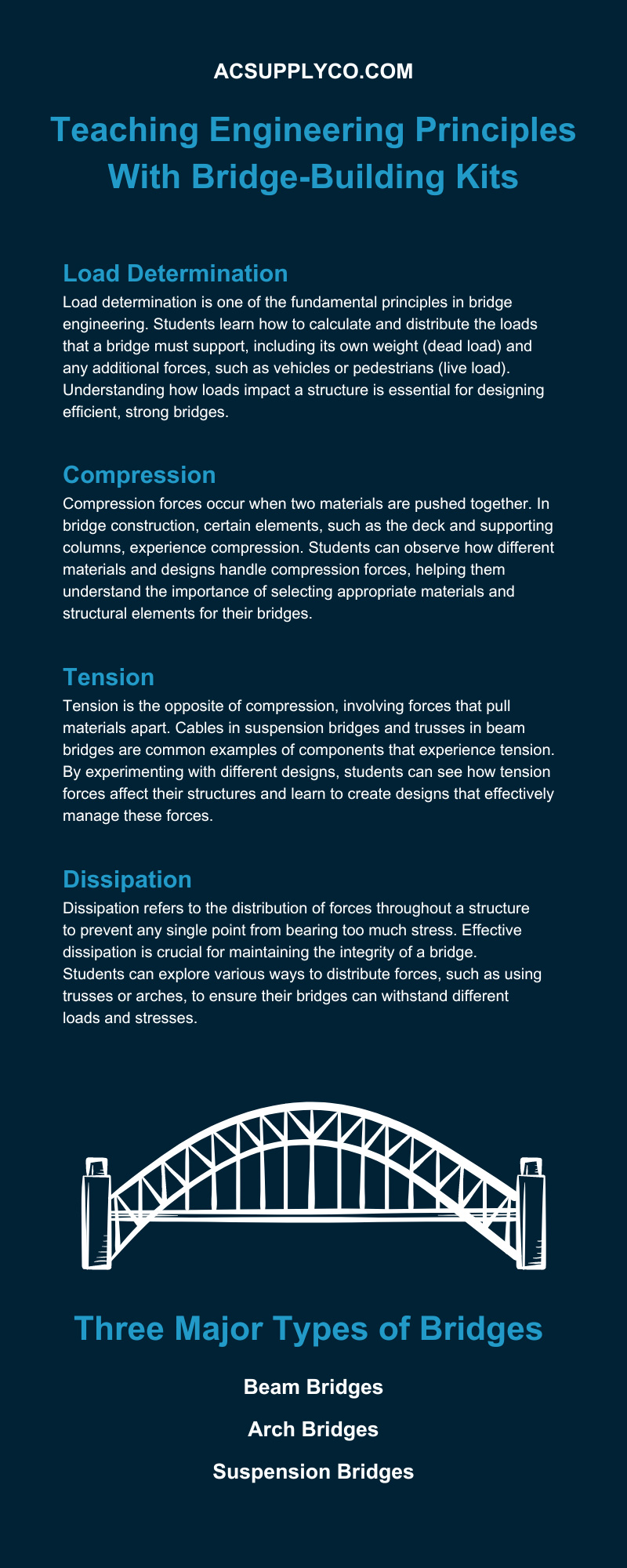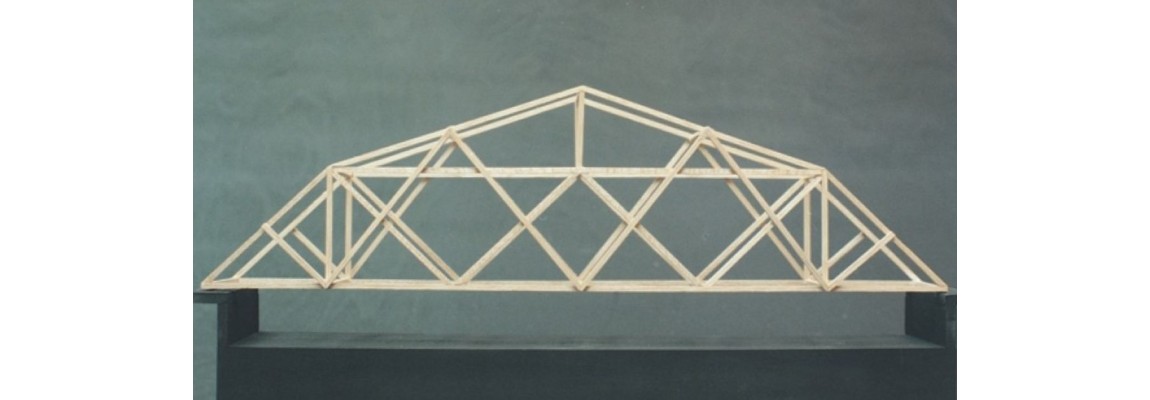Hands-on classroom activities are highly effective options for teaching engineering principles. One of the best ways to engage students in STEM (Science, Technology, Engineering, and Mathematics) education is through model bridge building.
Teaching engineering principles with bridge-building kits provides a practical, interactive learning experience that captivates students’ interests and enhances their understanding of fundamental engineering concepts. Let’s explore the benefits and learning opportunities that bridge building offers educators and students.
Why Model Bridge Building Is Great for STEM Classrooms
Model bridge building serves as an excellent educational tool in STEM classrooms. It allows students to apply theoretical knowledge to a tangible project, bridging the gap between abstract concepts and real-world applications. This hands-on approach fosters critical thinking, creativity, and problem-solving skills, which are essential for success in STEM fields.
Additionally, bridge-building projects encourage teamwork and collaboration, as students often work in groups to design and construct their models. This collaborative environment helps students develop communication skills and learn the importance of working together to achieve a common goal. Moreover, the challenge of building a functional bridge stimulates curiosity and motivation, making learning more engaging and enjoyable.
Engineering Principles Students Can Learn From Bridge Building
Through the process of designing and constructing model bridges, students gain a deeper understanding of several key engineering principles. These concepts are crucial for any aspiring engineer, and teachers can further emphasize this with bridge-building projects. Here are some of the top engineering principles students can expect to learn.
Load Determination
Load determination is one of the fundamental principles in bridge engineering. Students learn how to calculate and distribute the loads that a bridge must support, including its own weight (dead load) and any additional forces, such as vehicles or pedestrians (live load). Understanding how loads impact a structure is essential for designing efficient, strong bridges.
Compression
Compression forces occur when two materials are pushed together. In bridge construction, certain elements, such as the deck and supporting columns, experience compression. Students can observe how different materials and designs handle compression forces, helping them understand the importance of selecting appropriate materials and structural elements for their bridges.
Tension
Tension is the opposite of compression, involving forces that pull materials apart. Cables in suspension bridges and trusses in beam bridges are common examples of components that experience tension. By experimenting with different designs, students can see how tension forces affect their structures and learn to create designs that effectively manage these forces.
Dissipation
Dissipation refers to the distribution of forces throughout a structure to prevent any single point from bearing too much stress. Effective dissipation is crucial for maintaining the integrity of a bridge. Students can explore various ways to distribute forces, such as using trusses or arches, to ensure their bridges can withstand different loads and stresses.
Three Major Types of Bridges
Understanding the different types of bridges is an integral part of any bridge-building project. Each type has unique characteristics and applies different engineering principles, providing students with a comprehensive overview of bridge design. Here are the three major types of bridges students should know about.
Beam Bridges
Beam bridges are the simplest type of bridge, consisting of a horizontal beam supported at both ends by piers. The bridge must have a beam strong enough to withstand the forces of compression on the top and tension on the bottom. Beam bridges are an excellent starting point for students, as they illustrate basic concepts of load and force distribution.
Arch Bridges
Arch bridges use a curved structure to transfer loads through compression along the curve to the supports at either end. This design allows arch bridges to span longer distances than beam bridges while maintaining strength and stability. Building an arch bridge helps students understand how curved shapes can effectively distribute forces and support heavy loads.
Suspension Bridges
Suspension bridges use cables suspended between towers to support the bridge deck. The cables experience tension, while the towers handle compression forces. This design allows suspension bridges to span long distances and support heavy loads. Students building suspension bridges learn about the interplay between tension and compression and the importance of material strength and flexibility.
Model Bridge Building: A Fun, Educational School Project
Model bridge building is an educational, fun, and engaging project for students. Educators should follow several key steps to ensure students enjoy their bridge-building activities.
Gather All Bridge-Building Tools
Before starting the project, gather all the necessary tools and materials; these materials may include balsa wood, glue, cutting tools, and measuring instruments. Providing students with quality materials helps them focus on the engineering principles rather than struggle with inadequate supplies.
Set Goals for the Students
Clearly defined goals help students stay focused and motivated. Whether the objective is to build the longest bridge, the strongest bridge, or the most aesthetically pleasing bridge, setting specific goals gives students a clear target to work toward.
Provide Students With Clearly Defined Rules and Guidelines
Establishing rules and guidelines is crucial for maintaining a fair and organized project. These rules might include limitations on materials, size constraints, and specific design requirements. Clear guidelines help students understand the project’s expectations and encourage creativity within defined parameters.
Let Students Problem-Solve on Their Own
While guidance and support are important, allowing students to solve problems independently fosters critical thinking and innovation. Encourage students to experiment with unique designs and solutions, learning from their mistakes and successes.
Engineering Questions Students Should Ask When Building
As students embark on their bridge-building projects, they should consider several key engineering questions. These questions will guide their design processes and help them create functional and efficient bridges.
What Is the Preferred Length, Width, and Height of My Bridge?
Determining the optimal dimensions of a bridge is essential for its stability and functionality. Students should consider the span they must cover, the load the bridge will support, and any other specific requirements of the project.
How Will the Bridge’s Load Transfer Take Place?
Load transfer refers to how forces move through a structure. Students must design their bridges to efficiently transfer loads from the deck to the supports. Considering load transfer helps students create structures that distribute forces evenly and avoid weak points.
Will Any Traffic Come Across the Bridge?
Anticipating the type of traffic a bridge will support is vital for designing an appropriate structure. Whether it’s pedestrians, vehicles, or trains, certain types of traffic impose different loads and stresses on a bridge. Students should design their bridges to accommodate the expected traffic.
What Materials Can I Use When Building My Bridge?
Material selection is a critical aspect of bridge design. Students must choose materials that provide the necessary strength, flexibility, and durability for their bridges. Having a clear understanding of each material helps students make informed decisions and create effective designs.
Teaching engineering principles with bridge-building kits gives students a better understanding of key engineering concepts, such as load determination, compression, tension, and dissipation. By using model bridge kits from AC Supply, educators can create fun, educational environments that foster a deep understanding of engineering principles and prepare students for future success in STEM fields. Visit our website today for classroom supplies that will enhance your STEM curriculum.



